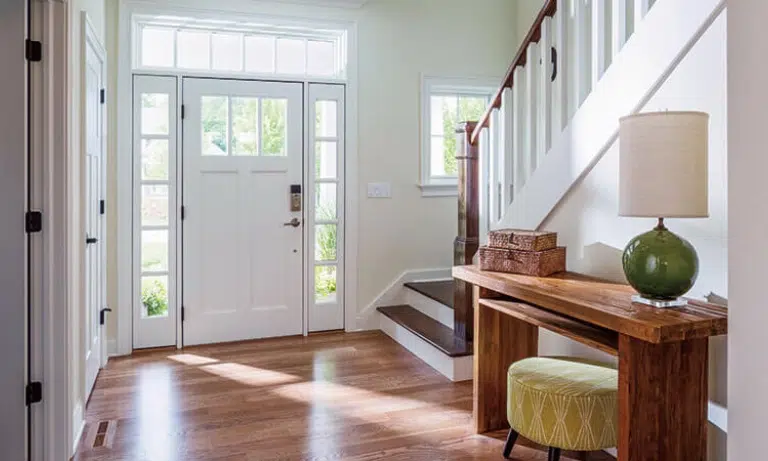When selecting an exterior door, homeowners must consider various factors, including durability, insulation, security, and maintenance. The right door material not only enhances curb appeal but also plays a crucial role in energy efficiency and home security. Three of the most popular options for exterior doors are wood, fiberglass, and steel. Each has its strengths and weaknesses, making it essential to choose the one that best suits your climate, lifestyle, and budget.
In this guide, we’ll compare these three materials in detail to help you make an informed decision.
1. Wood Exterior Doors
Timeless Beauty and Natural Warmth
Wooden doors have been a classic choice for centuries, offering a rich, natural look that enhances the aesthetics of any home. They are available in various species, including mahogany, oak, cherry, and walnut, allowing homeowners to customize their doors with stains and finishes that match their style.
Pros of Wood Doors:
✅ Aesthetic Appeal: The natural grain and texture provide an elegant, luxurious look.
✅ Customizable: Can be painted, stained, or carved for unique designs.
✅ Solid and Durable: High-quality hardwood doors can last decades with proper maintenance.
Cons of Wood Doors:
❌ Expensive: Wood doors tend to be the most expensive option.
❌ High Maintenance: Requires regular sealing or painting to prevent warping and rotting.
❌ Not as Energy Efficient: Solid wood does not provide as much insulation as fiberglass.
Best for:
- Traditional, rustic, or high-end homes looking for premium aesthetics.
- Locations with mild to moderate climates, as extreme weather can cause warping or swelling.
- Homeowners willing to invest in maintenance and refinishing over time.
2. Fiberglass Exterior Doors
Durability Meets Energy Efficiency
Fiberglass doors are an increasingly popular choice due to their excellent insulation, durability, and low maintenance. These doors can mimic the look of wood while offering superior weather resistance.
Pros of Fiberglass Doors:
✅ Highly Durable: Resistant to dents, cracks, warping, and rotting.
✅ Energy Efficient: Comes with insulated cores that provide excellent thermal performance.
✅ Low Maintenance: Requires minimal upkeep compared to wood.
✅ Customizable: Available in different finishes, including woodgrain textures.
Cons of Fiberglass Doors:
❌ Cost: More expensive than steel but still cheaper than high-end wood doors.
❌ Less Security than Steel: While durable, fiberglass can crack under extreme force.
❌ Not as Luxurious as Real Wood: While it imitates wood, some homeowners prefer the authentic look of solid wood.
Best for:
- Homes in extreme climates (hot or cold), as fiberglass resists weather-related damage.
- Homeowners looking for a low-maintenance door with good insulation.
- Those who want the look of wood without the upkeep.
3. Steel Exterior Doors
Maximum Security and Strength
Steel doors are the top choice for homeowners prioritizing security and affordability. They provide exceptional durability and can be insulated for improved energy efficiency.
Pros of Steel Doors:
✅ Strong and Secure: One of the most secure door materials available.
✅ Affordable: Less expensive than solid wood and often cheaper than fiberglass.
✅ Low Maintenance: Requires little upkeep and does not warp or rot.
✅ Energy Efficient: Insulated steel doors offer excellent thermal resistance.
Cons of Steel Doors:
❌ Susceptible to Dents and Rust: Can show signs of wear and tear more easily than other materials.
❌ Lacks Natural Aesthetic: Does not offer the same warmth and luxury as wood.
❌ Not Ideal for Coastal Areas: Prone to rust in humid or salty environments if not properly treated.
Best for:
- Budget-conscious homeowners looking for an affordable yet durable option.
- High-security needs, as steel provides the most protection against forced entry.
- Colder climates, as insulated steel doors prevent heat loss.
Comparison Table: Wood vs. Fiberglass vs. Steel
| Feature | Wood | Fiberglass | Steel |
|---|---|---|---|
| Durability | Moderate (requires maintenance) | High (resists warping/cracking) | High (but prone to dents) |
| Security | Moderate | Moderate | High |
| Insulation | Low to Moderate | High | High (with insulation) |
| Aesthetic Appeal | High | Moderate (imitates wood) | Low |
| Maintenance | High | Low | Low |
| Cost | High | Moderate | Low |
Expert Recommendations: How to Choose the Right Exterior Door Material
- For homeowners who prioritize aesthetics and customization, wood doors are the best option, provided they are ready to invest in maintenance.
- If you want an energy-efficient, durable, and low-maintenance solution, go for fiberglass.
- For budget-conscious homeowners looking for security and strength, steel doors offer the best protection.
Climate Considerations:
- Cold Climates: Fiberglass or insulated steel doors for maximum heat retention.
- Hot/Humid Climates: Fiberglass doors are resistant to warping and moisture damage.
- Coastal Areas: Avoid steel doors due to rust risk; fiberglass is the best option.
Final Thoughts: Investing in the Right Exterior Door
Your exterior door plays a significant role in your home’s curb appeal, energy efficiency, and security. While wood offers timeless elegance, fiberglass balances durability and energy efficiency, and steel provides top-tier security. Assess your budget, climate, and lifestyle needs to choose the right material.
Upgrading to the best exterior door material ensures your home remains stylish, secure, and energy-efficient for years to come.
Are You Ready to Upgrade Your Exterior Door?
If you’re considering a new door installation, consult with experts to find the best material for your specific needs. A well-chosen exterior door enhances both home value and daily convenience.

